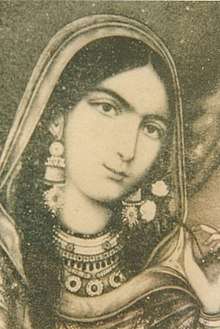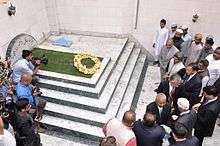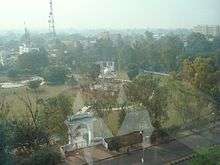Begum Hazrat Mahal
Begum Hazrat Mahal ( بیگم حضرت محل ) [name in Urdu] (c. 1820 – 7 April 1879), also called as Begum of Awadh, was the second wife of Nawab Wajid Ali Shah. Wajid Ali Shah met her in his palace. She rebelled against the British East India Company during the Indian Rebellion of 1857. She finally found asylum in Nepal where she died in 1879. After her husband had been exiled to Calcutta, she took charge of the affairs in the state of Awadh and seized control of Lucknow. She organised an army of women and placed Uda Devi as its commander. She actively took part in the revolt of 1857 against the Doctrine of Lapse under which Dalhousie wanted her to surrender Lucknow. She gave stiff resistance. But after the fall of Lucknow she escaped to Kathmandu.[2] She was a very brave woman and such bravery in a male-dominated society was unprecedented.[3] She made her son, Prince Birjis Qadr, the Wali (ruler) of Awadh; However, she was forced to abandon this role after a short reign.[4] "Pasi respondents first documented the story of Begum Hazrat Mahal in print in the 1971 Census records. Though the name of Uda Devi was not mentioned, the respondents mentioned that, in the war of 1857, a Pasi Palton (a platoon of Pasis) rescued Begum Hazrat Mahal from imprisonment by the British (Census of India 1971: 2). It was only later that the story of Uda Devi came to be incorporated into the narrative. After 1990, the story found organisational support for its transmission and celebration with the formation of the Virangana Uda Devi Smarak Sansthan."[5]
| Begum Hazrat Mahal | |
|---|---|
| Begum of Awadh | |
 Begum Hazrat Mahal | |
| Born | Muhammadi Khanum 1820 Faizabad, Awadh |
| Died | 7 April 1879 (aged 59) Kathmandu, Nepal |
| Husband | Nawab Wajid Ali Shah |
| Religion | Shia Islam[1] |
Biography
Mahal's name was Muhammadi Khanum, and she was born at Faizabad, Awadh, India. She was a courtesan by profession and had been taken into the royal harem as a khawasin after being sold by her parents, then to Royal agents, and later promoted to a pari,[6] and was known as Mahak Pari. She became a begum after being accepted as a royal concubine of the King of Awadh,[7] and the title 'Hazrat Mahal' was bestowed on her after the birth of their son, Birjis Qadra.
She was a junior[8] wife of the last Tajdaar-e-Awadh, Wajid Ali Shah. The British had annexed Awadh in 1856 and Wajid Ali Shah was exiled to Calcutta. After her husband was exiled to Calcutta, she took charge of the affairs of the state of Awadh despite her divorce from the Nawab,[9] which then was a large part of the current state of Uttar Pradesh, India.
Indian Rebellion of 1857
During the [Indian Rebellion of 1857], from 1857 to 1858, Begum Hazrat Mahal's band of supporters, led by Raja Jailal Singh, rebelled against the forces of the British; later, they seized control of Lucknow and she declared her son, Birjis Qadr, as the ruler (Wali) of Oudh.[6]
One of the principal complaints of Begum Hazrat Mahal was that the East India Company had casually demolished Temples and mosques just to make way for roads.[10] In a proclamation issued during the final days of the revolt, she mocked the British claim to allow freedom of worship:[10]
To eat pigs and drink wine, to bite greased cartridges and to mix pig's fat with sweetmeats, to destroy Hindu and Mussalman temples on pretense of making roads, to build churches, to send clergymen into the streets to preach the Christian religion, to institute English schools, and pay people a monthly stipend for learning the English sciences, while the places of worship of Hindus and Mussalmans are to this day entirely neglected; with all this, how can people believe that religion will not be interfered with?[10]
When the forces under the command of the British re-captured Lucknow and most of Oudh, she was forced to retreat. Hazrat Mahal worked in association with Nana Saheb, but later joined the Maulavi of Faizabad in the attack on Shahjahanpur.
Later life
Ultimately, she had to retreat to Nepal, where she was initially refused asylum by the Rana prime minister Jang Bahadur,[11] but was later allowed to stay.[12] She died there in 1879 and was buried in a nameless grave in the grounds of Kathmandu's Jama Masjid.[13] After her death, on the occasion of the jubilee of Queen Victoria (1887), the British Government pardoned Birjis Qadar and he was allowed to return home.[14]
Memorials

Begum Hazrat Mahal's tomb is located in central part of Kathmandu near Jama Masjid, Ghantaghar, not far away from the famous Darbar Marg. It is looked after by the Jama Masjid Central Committee.[4]

On 15 August 1962, Mahal was honoured at the Old Victoria Park in Hazratganj, Lucknow for her role in the Great Revolt.[15][16][17] Along with the renaming of the park, a marble memorial was constructed, which includes a marble tablet with four round brass plaques bearing the Coat of Arms of the Awadh royal family. The park has been used for Ramlilas and bonfires during Dusshera, as well as Lucknow Mahotsava (Lucknow Exposition).[18]
On 10 May 1984, the Government of India issued a commemorative stamp in honour of Mahal. The first day cover was designed by C.R. Pakrashi, and the cancellation was done by Alka Sharma. 15,00,000 stamps were issued.[19][15]
The Ministry of Minority Affairs, Government of India has started the Begum Hazrat Mahal National Scholarship for Meritorious Girls belonging to minority communities in India. This scholarship is implemented through the Maulana Azad Education Foundation.[20][21]
References
- "Begum Hazrat Mahal Biography, History and Facts". 3 February 2018.
- Raja, Masood Ashraf (10 October 2018), "Competing habitus", The Routledge Companion to Pakistani Anglophone Writing, Routledge, pp. 348–359, doi:10.4324/9781315180618-30, ISBN 9781315180618
- Narayan, Badri (February 2004). "Inventing caste history: Dalit mobilisation and nationalist past". Contributions to Indian Sociology. 38 (1–2): 202. doi:10.1177/006996670403800108. ISSN 0069-9667.
- "A link to Indian freedom movement in Nepal". The Hindu. 8 April 2014.
- Narayan, Badri (February 2004). "Inventing caste history: Dalit mobilisation and nationalist past". Contributions to Indian Sociology. 38 (1–2): 199. doi:10.1177/006996670403800108. ISSN 0069-9667.
- Michael Edwardes (1975) Red Year. London: Sphere Books; p. 104
- Christopher Hibbert (1980) The Great Mutiny, Harmondsworth: Penguin; p. 371
- Saul David (2002) The Indian Mutiny, Viking; p. 185
- "Begum Hazrat Mahal". Mapsofindia.com. Retrieved 18 October 2012.
- William Dalrymple The Last Mughal; the fall of a dynasty: Delhi, 1857, Viking Penguin, 2006, p. 69
- Hibbert (1980); pp. 374–375
- Hibbert (1980); pp. 386–387
- Krishna, Sharmila (11 June 2002). "Far from the madding crowd she lies, forlorn & forgotten". The Indian Express - LUCKNOW. Retrieved 3 September 2013.
- Harcourt, E.S (2012). Lucknow the Last Phase of an Oriental Culture (seventh ed.). Delhi: Oxford University Press. p. 76. ISBN 978-0-19-563375-7.
- "Little known, little remembered: Begum Hazrat Mahal". milligazette.com. Retrieved 14 September 2016.
- Ruggles, D. Fairchild (2014). Woman's Eye, Woman's Hand: Making Art and Architecture in Modern India. Zubaan. ISBN 9789383074785.
- Yecurī, Sītārāma (2008). The great revolt, a left appraisal. People's Democracy. ISBN 9788190621809.
- "Begum Hazrat Mahal in Lucknow | My India". Mapsofindia.com. 27 August 2013. Retrieved 14 September 2016.
- "Begum Hazrat Mahal". Indianpost.com. Retrieved 18 October 2012.
- "Begum Hazrat Mahal National Scholarship". 24 May 2020. Archived from the original on 1 June 2018.
- "Begum Hazrat Mahal Scholarship".